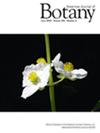A phylogenomic investigation into the biogeography of the Mexico–eastern U.S. disjunction in Symphyotrichum
Abstract
Premise
Biotic disjunctions have attracted scientific attention for the past 200 years. Despite being represented in many familiar plants (such as bald cypress, flowering dogwood, sweetgum, partridgeberry, etc.), the eastern North American (ENA)–Mexican (M) disjunction remains poorly understood. Major outstanding questions include the divergence times of taxa exhibiting the disjunction and environmental/geological processes that may underlie the disjunction. Symphyotrichum Nees (Asteraceae), one of the most diverse genera in the eastern USA, displays several examples of disjunct ENA–M taxa.
Methods
We generated target capture data using the Angiosperms353 baitset and generated the first well-sampled phylogenomic hypothesis for Symphyotrichum and its close relatives. Focusing on S. subgenus Virgulus, we used MCMCTREE to perform divergence time estimation and the R package BioGeoBEARS to infer ancestral regions and biogeographic transitions between North America and Mexico. Finally, we used the ancestral niche reconstruction method Utremi to test for a role of historical aridification in generating the disjunction.
Results
Our molecular data suggest a recent radiation of Symphyotrichum at the Plio-Pleistocene boundary (~2.5 mya), with early connections to Mexico in ancestral lineages that closed off shortly after and were followed by vicariance across this region. Except for some present-day broadly distributed species, there is a complete lack of movement between ENA and M after ~0.5 mya.
Conclusions
A reconstructed disjunct distribution of suitable habitat in Pleistocene climatic models corroborates results from biogeographic modeling and confirms glacial cycles are more likely to be associated with the breakup of ENA–M biogeographic connections.




 求助内容:
求助内容: 应助结果提醒方式:
应助结果提醒方式:


